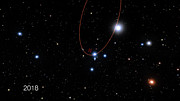Artist’s impression of the star S2 passing very close to the supermassive black hole at the centre of the Milky Way
PR Image eso1622b
The centre of the Milky Way
Videos
A European team of astronomers have used
the new GRAVITY instrument at ESO’s Very Large Telescope to obtain
exciting observations of the centre of the Milky Way by combining light
from all four of the 8.2-metre Unit Telescopes for the first time. These
results provide a taste of the groundbreaking science that GRAVITY will
produce as it probes the extremely strong gravitational fields close to
the central supermassive black hole and tests Einstein’s general
relativity.
The GRAVITY instrument is now operating with the four 8.2-metre Unit Telescopes of ESO’s Very Large Telescope (VLT), and even from early test results it is already clear that it will soon be producing world-class science.
GRAVITY is part of the VLT Interferometer.
By combining light from the four telescopes it can achieve the same
spatial resolution and precision in measuring positions as a telescope
of up to 130 metres in diameter.
The corresponding gains in resolving power
and positional accuracy — a factor of 15 over the individual 8.2-metre
VLT Unit Telescopes — will enable GRAVITY to make amazingly accurate
measurements of astronomical objects.
One of GRAVITY’s primary goals is to make detailed observations of the surroundings of the 4 million solar mass black hole at the very centre of the Milky Way [1].
Although the position and mass of the black hole have been known since
2002, by making precision measurements of the motions of stars orbiting
it, GRAVITY will allow astronomers to probe the gravitational field around the black hole in unprecedented detail, providing a unique test of Einstein’s general theory of relativity.
In this regard, the first observations with GRAVITY are already very exciting. The GRAVITY team [2]
has used the instrument to observe a star known as S2 as it orbits the
black hole at the centre of our galaxy with a period of only 16 years.
These tests have impressively demonstrated GRAVITY’s sensitivity as it
was able to see this faint star in just a few minutes of observation.
The team will soon be able to obtain ultra-precise positions of the
orbiting star, equivalent to measuring the position of an object on the
Moon with centimetre precision. That will enable them to determine
whether the motion around the black hole follows the predictions of
Einstein’s general relativity — or not. The new observations show that
the Galactic Centre is as ideal a laboratory as one can hope for.
"It was a fantastic moment for the whole team when the light from
the star interfered for the first time — after eight years of hard
work," says GRAVITY’s lead scientist Frank Eisenhauer from the Max
Planck Institute for Extraterrestrial Physics in Garching, Germany. "First
we actively stabilised the interference on a bright nearby star, and
then only a few minutes later we could really see the interference from
the faint star — to a lot of high-fives.” At first glance neither
the reference star nor the orbiting star have massive companions that
would complicate the observations and analysis. "They are ideal probes," explains Eisenhauer.
This early indication of success does not come a moment too soon. In
2018 the S2 star will be at its closest to the black hole, just 17
light-hours away from it and travelling at almost 30 million kilometres
per hour, or 2.5% of the speed of light. At this distance the effects
due to general relativity will be most pronounced and GRAVITY
observations will yield their most important results [3]. This opportunity will not be repeated for another 16 years.
Notes
[1] The centre of the Milky Way, our home galaxy, lies on the sky in
the constellation of Sagittarius (The Archer) and is some 25 000
light-years distant from Earth.
[2] The GRAVITY consortium consists
of: the Max Planck Institutes for Extraterrestrial Physics (MPE) and
Astronomy (MPIA), LESIA of Paris Observatory and IPAG of Université
Grenoble Alpes/CNRS, the University of Cologne, the Centro
Multidisciplinar de Astrofísica Lisbon and Porto (SIM), and ESO.
[3] The team will, for the first time, be able to measure two relativistic effects for a star orbiting a massive black hole — the gravitational redshift and the precession of the pericentre. The redshift arises because light from the star has to move against the strong gravitational field of the massive black hole in order to escape into the Universe. As it does so it loses energy, which manifests as a redshift of the light. The second effect applies to the star’s orbit and leads to a deviation from a perfect ellipse. The orientation of the ellipse rotates by around half a degree in the orbital plane when the star passes close to the black hole. The same effect has been observed for Mercury's orbit around the Sun, where it is about 6500 times weaker per orbit than in the extreme vicinity of the black hole. But the larger distance makes it much harder to observe in the Galactic Centre than in the Solar System.
More Information
ESO is the foremost
intergovernmental astronomy organisation in Europe and the world’s most
productive ground-based astronomical observatory by far. It is supported
by 16 countries: Austria, Belgium, Brazil, the Czech Republic, Denmark,
France, Finland, Germany, Italy, the Netherlands, Poland, Portugal,
Spain, Sweden, Switzerland and the United Kingdom, along with the host
state of Chile. ESO carries out an ambitious programme focused on the
design, construction and operation of powerful ground-based observing
facilities enabling astronomers to make important scientific
discoveries. ESO also plays a leading role in promoting and organising
cooperation in astronomical research. ESO operates three unique
world-class observing sites in Chile: La Silla, Paranal and Chajnantor.
At Paranal, ESO operates the Very Large Telescope, the world’s most
advanced visible-light astronomical observatory and two survey
telescopes. VISTA works in the infrared and is the world’s largest
survey telescope and the VLT Survey Telescope is the largest telescope
designed to exclusively survey the skies in visible light. ESO is a
major partner in ALMA, the largest astronomical project in existence.
And on Cerro Armazones, close to Paranal, ESO is building the 39-metre
European Extremely Large Telescope, the E-ELT, which will become “the
world’s biggest eye on the sky”.
Links
- First light of GRAVITY (ESO)
- First light of GRAVITY (MPE)
- GRAVITY instrument web page (ESO)
- GRAVITY instrument web page (MPE)
- Orbits of stars around the galactic centre (ESO)
- Orbits of stars around the galactic centre (MPE)
Contacts
Frank Eisenhauer
GRAVITY Principal Investigator, Max Planck Institute for Extraterrestrial Physics
Garching, Germany
Tel: +49 (89) 30 000 3563
Email: eisenhau@mpe.mpg.de
Richard Hook
ESO Public Information Officer
Garching bei München, Germany
Tel: +49 89 3200 6655
Cell: +49 151 1537 3591
Email: rhook@eso.org
ESO Public Information Officer
Garching bei München, Germany
Tel: +49 89 3200 6655
Cell: +49 151 1537 3591
Email: rhook@eso.org
Hannelore Hämmerle
Public Information Officer, Max Planck Institute for Extraterrestrial Physics
Garching, Germany
Tel: +49 (89) 30 000 3980
Email: hannelore.haemmerle@mpe.mpg.de
Public Information Officer, Max Planck Institute for Extraterrestrial Physics
Garching, Germany
Tel: +49 (89) 30 000 3980
Email: hannelore.haemmerle@mpe.mpg.de
Source: ESO



